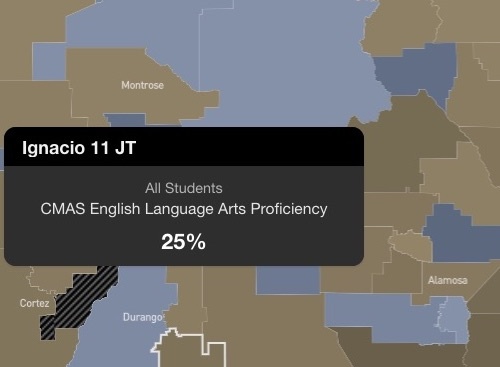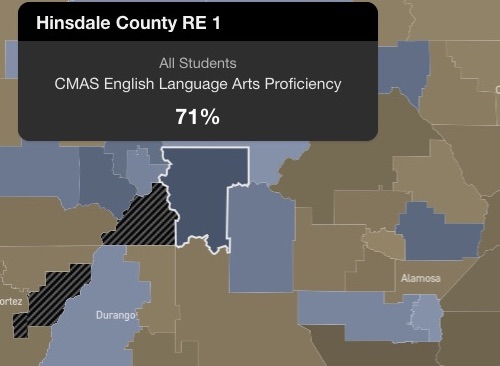Yesterday in Part Three, I shared some optimistic comments from Archuleta School District board president Bob Lynch, concerning CMAS and CTE. I also reached out to Christa Laos, who is running against Mr. Lynch for the District 2 School Board seat, and I received these comments:
“Thank you, Bill, for keeping the conversation going. I also question the efficiency and meaning of test scores. In particular, what do the ongoing poor results indicate for our school district? My current 5th grader has never taken a test and his retention of the material we cover is amazing. It is not just that he is homeschooled. Even within a classroom, if teachers are able to teach and assess the children themselves without the burden of testing and requirements, children would thrive.
“Since 2005, I have volunteered hundreds of hours at the Pagosa Springs Elementary School and PPOS. Because I have been a small business owner for over ten years in the trades, I have been able to cultivate working full time and homeschooling my child. Not everyone has this opportunity. I believe in the trades and my entire vocational life has been in service. Being able to have access to trade training in our school district is an important step for our success. And, I will continue to support it.
“Personally, I feel my success is not just based upon my knowledge of the tools I use. My business is also based on my love for my work. I truly care about my clients and I continually learn. My high school education was superb and geared towards kids having the opportunity to do higher education if they chose to. I intend to keep the goals and possibilities of all the children in our school district in mind by assessing their particular accomplishments. This includes gaining knowledge from their teacher’s wisdom and by understanding the love that is cultivated for them by their parents and caregivers. This can look like continued education or it can be cultivating trades immediately with our amazing programs. Either way, I am confident that our children can help us overcome the many challenges facing our community including affordable housing.”
Ms. Laos brings up some key points.
(Please note that this editorial series is not intended as an endorsement of any particular School Board candidates. Also, please note that I currently serve as a volunteer member of the Pagosa Peak Open School board of directors, but this editorial series reflects only my own personal opinions, and not necessarily those of the PPOS board as a whole.)
Ms. Laos mentions that her son is homeschooling and “has never taken a test” and yet, she says, his retention of materials is “amazing”. Like many people, she questions the efficiency and meaning of test scores — presumably including the CMAS (Colorado Measures of Academic Success) standardized tests administered in all public schools in Colorado.
Let’s consider, for a moment, the idea of a “test”. Because there are various reasons for testing someone’s knowledge, skill, and understanding.
If we were hiring, say, a police officer, who will be carrying a gun and enforcing state laws, it will be prudent — for the good of the whole community — to test their knowledge of the law and the proper handling of firearms. We would want to test their knowledge about how to de-escalate a potentially dangerous situation. We would want to test their ability to write a report accurately and coherently… a report that might be referenced, later, in a court case.
But those kinds of concerns don’t apply to the tests given to children in public schools.
Traditionally, teachers have given quizzes and tests for three general reasons:
1. An upcoming test creates an artificial deadline for memorizing some set of facts or words, or for learning a certain processes… by a certain date. We know that, without an artificial deadline, a student might have little innate interest in memorizing the information or practicing the skill being tested. It’s a tool for pressuring a student to learn something they wouldn’t necessarily care to learn on their own.
2. Test results, as they are traditionally used, provide the teacher with information about which students are struggling with information or processes, so that revised teaching strategies can be applied, as needed.
3. The test is typically returned to the student with a ‘grade’ attached, to allow the student to assess their performance and to review the answers that the student got ‘right’ or ‘wrong’ — typically, to help the student prepare for ‘finals’. The student’s ‘final grade’ is often based largely on test performances.
That is to say, tests are traditionally aimed at improving the acquisition of knowledge and skill by the student, by providing useful feedback to the student and to the teacher.
The CMAS test is a rather different animal. The test is given in April… and the results are published in September… after the student has started a new grade with a new teacher.
The student is not provided with a ‘graded’ copy of the test, allowing them to review which questions they answered incorrectly. The teacher is also not provided a ‘graded’ copy of the test… but of course, the student has already left their class, so what good would that do?
The essential purpose of the CMAS test is not to provide useful feedback to and about an individual student. The essential purpose of the CMAS test is to provide aggregated statistics which are then used rank the school and the district, in comparison to other schools and districts.
The ‘final grade’ is not provided to the student, nor to the teacher, to allow them to improve their learning interactions. The ‘final grade’ is assigned to the institution, as a statistic.



The key outcome of the CMAS test, is the conversion of test data into aggregated statistics. People have ceased to be centrally important; what is important is ‘data’.
Sadly, the statistics to which our schools and districts get reduced, and on which they are ranked, are based on just two basic academic skills.
1. Reading and writing
2. Math
Just two of the hundreds of useful skills that could benefit a human being, and their community, in 2023.
